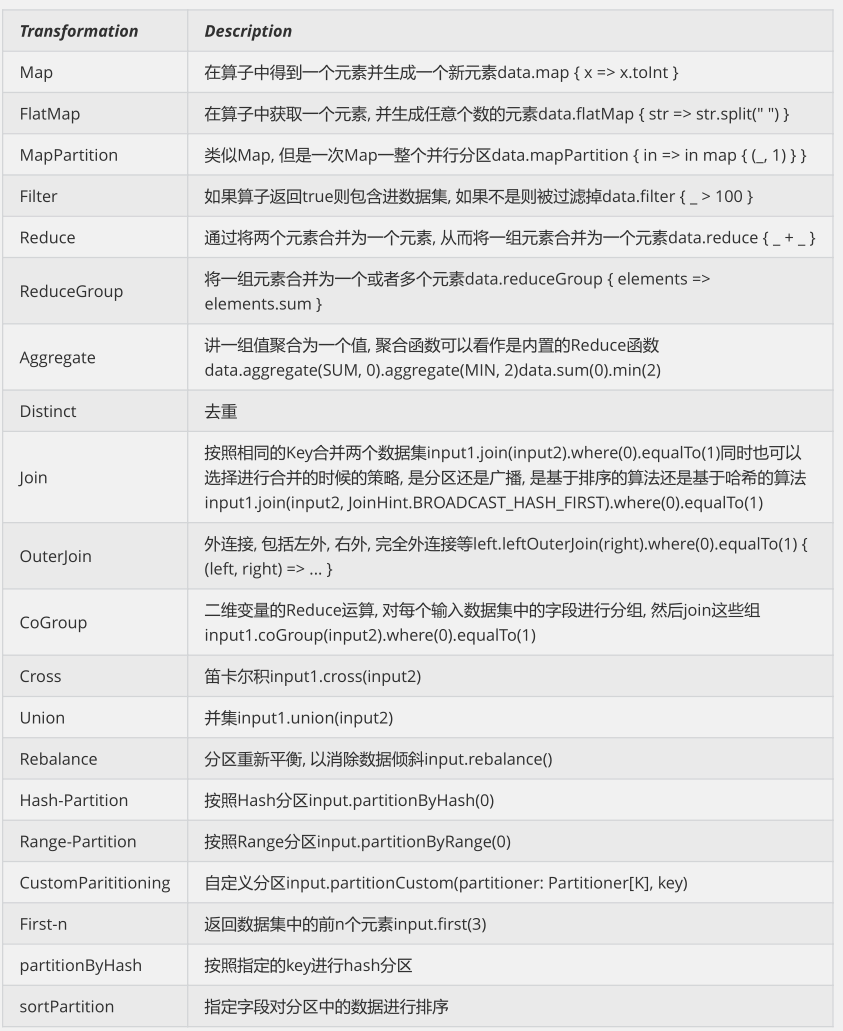这篇文章主要介绍“Flink数据流DataStream和DataSet怎么使用”,在日常操作中,相信很多人在Flink数据流DataStream和DataSet怎么使用问题上存在疑惑,小编查阅了各式资料,整理出简单好用的操作方法,希望对大家解答”Flink数据流DataStream和DataSet怎么使用”的疑惑有所帮助!接下来,请跟着小编一起来学习吧!
Flink主要用来处理数据流,所以从抽象上来看就是对数据流的处理,正如前面大数据开发-Flink-体系结构 && 运行架构提到写Flink程序实际上就是在写DataSource、Transformation、Sink.
DataSource是程序的数据源输入,可以通过StreamExecutionEnvironment.addSource(sourceFuntion)为程序 添加一个数据源
Transformation是具体的操作,它对一个或多个输入数据源进行计算处理,比如Map、FlatMap和Filter等操作
Sink是程序的输出,它可以把Transformation处理之后的数据输出到指定的存储介质中
Flink针对DataStream提供了两种实现方式的数据源,可以归纳为以下四种:
基于文件
readTextFile(path) 读取文本文件,文件遵循TextInputFormat逐行读取规则并返回
基于Socket
socketTextStream 从Socket中读取数据,元素可以通过一个分隔符分开
基于集合
fromCollection(Collection) 通过Java的Collection集合创建一个数据流,集合中的所有元素必须是相同类型的,需要注意的是,如果集合里面的元素要识别为POJO,需要满足下面的条件
总结:上面的要求其实就是为了让Flink可以方便地序列化和反序列化这些对象为数据流
该类有共有的无参构造方法
该类是共有且独立的(没有非静态内部类)
类(及父类)中所有的不被static、transient修饰的属性要么有公有的(且不被final修饰),要么是包含公有的getter和setter方法,这些方法遵循java bean命名规范
自定义Source
使用StreamExecutionEnvironment.addSource(sourceFunction)将一个流式数据源加到程序中,具体这个sourceFunction 是为非并行源implements SourceFunction,或者为并行源 implements ParallelSourceFunction接口,或者extends RichParallelSourceFunction,对于自定义Source,Sink, Flink内置了下面几种Connector
| 连接器 | 是否提供Source支持 | 是否提供Sink支持 |
|---|---|---|
| Apache Kafka | 是 | 是 |
| ElasticSearch | 否 | 是 |
| HDFS | 否 | 是 |
| Twitter Streaming PI | 是 | 否 |
对于Source的使用,其实较简单,这里给一个较常用的自定义Source的KafaSource的使用例子。更多相关源码可以查看:
package com.hoult.stream;
public class SourceFromKafka {
public static void main(String[] args) throws Exception {
StreamExecutionEnvironment env = StreamExecutionEnvironment.getExecutionEnvironment();
String topic = "animalN";
Properties props = new Properties();
props.put("bootstrap.servers", "linux121:9092");
FlinkKafkaConsumer<String> consumer = new FlinkKafkaConsumer<>(topic, new SimpleStringSchema(), props);
DataStreamSource<String> data = env.addSource(consumer);
SingleOutputStreamOperator<Tuple2<Long, Long>> maped = data.map(new MapFunction<String, Tuple2<Long, Long>>() {
@Override
public Tuple2<Long, Long> map(String value) throws Exception {
System.out.println(value);
Tuple2<Long,Long> t = new Tuple2<Long,Long>(0l,0l);
String[] split = value.split(",");
try{
t = new Tuple2<Long, Long>(Long.valueOf(split[0]), Long.valueOf(split[1]));
} catch (Exception e) {
e.printStackTrace();
}
return t;
}
});
KeyedStream<Tuple2<Long,Long>, Long> keyed = maped.keyBy(value -> value.f0);
//按照key分组策略,对流式数据调用状态化处理
SingleOutputStreamOperator<Tuple2<Long, Long>> flatMaped = keyed.flatMap(new RichFlatMapFunction<Tuple2<Long, Long>, Tuple2<Long, Long>>() {
ValueState<Tuple2<Long, Long>> sumState;
@Override
public void open(Configuration parameters) throws Exception {
//在open方法中做出State
ValueStateDescriptor<Tuple2<Long, Long>> descriptor = new ValueStateDescriptor<>(
"average",
TypeInformation.of(new TypeHint<Tuple2<Long, Long>>() {
}),
Tuple2.of(0L, 0L)
);
sumState = getRuntimeContext().getState(descriptor);
// super.open(parameters);
}
@Override
public void flatMap(Tuple2<Long, Long> value, Collector<Tuple2<Long, Long>> out) throws Exception {
//在flatMap方法中,更新State
Tuple2<Long, Long> currentSum = sumState.value();
currentSum.f0 += 1;
currentSum.f1 += value.f1;
sumState.update(currentSum);
out.collect(currentSum);
/*if (currentSum.f0 == 2) {
long avarage = currentSum.f1 / currentSum.f0;
out.collect(new Tuple2<>(value.f0, avarage));
sumState.clear();
}*/
}
});
flatMaped.print();
env.execute();
}
}对于Transformation ,Flink提供了很多的算子,
map
DataStream → DataStream Takes one element and produces one element. A map function that doubles the values of the input stream:
DataStream<Integer> dataStream = //...
dataStream.map(new MapFunction<Integer, Integer>() {
@Override
public Integer map(Integer value) throws Exception {
return 2 * value;
}
});flatMap
DataStream → DataStream Takes one element and produces zero, one, or more elements. A flatmap function that splits sentences to words:
dataStream.flatMap(new FlatMapFunction<String, String>() {
@Override
public void flatMap(String value, Collector<String> out) throws Exception {
for(String word: value.split(" ")){
out.collect(word);
}
}
});filter
DataStream → DataStream Evaluates a boolean function for each element and retains those for which the function returns true. A filter that filters out zero values:
dataStream.filter(new FilterFunction<Integer>() {
@Override
public boolean filter(Integer value) throws Exception {
return value != 0;
}
});keyBy
DataStream → KeyedStream Logically partitions a stream into disjoint partitions. All records with the same key are assigned to the same partition. Internally, keyBy() is implemented with hash partitioning. There are different ways to specify keys. This transformation returns a KeyedStream, which is, among other things, required to use keyed state.
Attention A type cannot be a key if:
fold
aggregation
window/windowAll/window.apply/window.reduce/window.fold/window.aggregation
dataStream.keyBy(value -> value.getSomeKey()) // Key by field "someKey" dataStream.keyBy(value -> value.f0) // Key by the first element of a Tuple
更多算子操作可以查看官网,官网写的很好:https://ci.apache.org/projects/flink/flink-docs-release-1.13/docs/dev/datastream/operators/overview/
Flink针对DataStream提供了大量的已经实现的数据目的地(Sink),具体如下所示
writeAsText():讲元素以字符串形式逐行写入,这些字符串通过调用每个元素的toString()方法来获取
print()/printToErr():打印每个元素的toString()方法的值到标准输出或者标准错误输出流中
自定义输出:addSink可以实现把数据输出到第三方存储介质中, Flink提供了一批内置的Connector,其中有的Connector会提供对应的Sink支持
这里举一个常见的例子,下层到Kafka
import org.apache.flink.api.common.serialization.SimpleStringSchema;
import org.apache.flink.streaming.api.datastream.DataStreamSource;
import org.apache.flink.streaming.api.environment.StreamExecutionEnvironment;
import org.apache.flink.streaming.connectors.kafka.FlinkKafkaProducer;
public class StreamToKafka {
public static void main(String[] args) throws Exception {
StreamExecutionEnvironment env = StreamExecutionEnvironment.getExecutionEnvironment();
DataStreamSource<String> data = env.socketTextStream("teacher2", 7777);
String brokerList = "teacher2:9092";
String topic = "mytopic2";
FlinkKafkaProducer producer = new FlinkKafkaProducer(brokerList, topic, new SimpleStringSchema());
data.addSink(producer);
env.execute();
}
}对DataSet批处理而言,较为频繁的操作是读取HDFS中的文件数据,因为这里主要介绍两个DataSource组件
基于集合 ,用来测试和DataStream类似
基于文件 readTextFile....

Flink针对DataStream提供了大量的已经实现的数据目的地(Sink),具体如下所示
writeAsText():将元素以字符串形式逐行写入,这些字符串通过调用每个元素的toString()方法来获取
writeAsCsv():将元组以逗号分隔写入文件中,行及字段之间的分隔是可配置的,每个字段的值来自对象的
toString()方法
print()/pringToErr():打印每个元素的toString()方法的值到标准输出或者标准错误输出流中 Flink提供了一批内置的Connector,其中有的Connector会提供对应的Sink支持。
到此,关于“Flink数据流DataStream和DataSet怎么使用”的学习就结束了,希望能够解决大家的疑惑。理论与实践的搭配能更好的帮助大家学习,快去试试吧!若想继续学习更多相关知识,请继续关注亿速云网站,小编会继续努力为大家带来更多实用的文章!
免责声明:本站发布的内容(图片、视频和文字)以原创、转载和分享为主,文章观点不代表本网站立场,如果涉及侵权请联系站长邮箱:is@yisu.com进行举报,并提供相关证据,一经查实,将立刻删除涉嫌侵权内容。